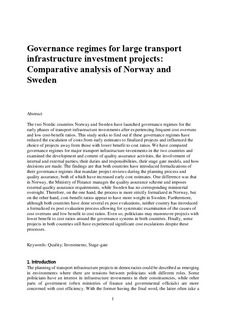| dc.contributor.author | Olsson, Nils | |
| dc.contributor.author | Nyström, Johan | |
| dc.contributor.author | Pyddoke, Roger | |
| dc.date.accessioned | 2019-12-16T14:32:27Z | |
| dc.date.available | 2019-12-16T14:32:27Z | |
| dc.date.created | 2019-08-28T10:17:22Z | |
| dc.date.issued | 2019 | |
| dc.identifier.citation | Case Studies on Transport Policy. 2019, 7 (4), 837-848. | nb_NO |
| dc.identifier.issn | 2213-624X | |
| dc.identifier.uri | http://hdl.handle.net/11250/2633467 | |
| dc.description.abstract | The two Nordic countries Norway and Sweden have launched governance regimes for the early phases of transport infrastructure investments after experiencing frequent cost overruns and low cost-benefit ratios. This study seeks to find out if these governance regimes have reduced the escalation of costs from early estimates to finalized projects and influenced the choice of projects away from those with lower benefit to cost ratios. We have compared governance regimes for major transport infrastructure investments in the two countries and examined the development and content of quality assurance activities, the involvement of internal and external parties, their duties and responsibilities, their stage gate models, and how decisions are made. The findings are that both countries have introduced formalizations of their governance regimes that mandate project reviews during the planning process and quality assurance, both of which have increased early cost estimates. One difference was that in Norway, the Ministry of Finance manages the quality assurance scheme and imposes external quality assurance requirements, while Sweden has no corresponding ministerial oversight. Therefore, on the one hand, the process is more strictly formalized in Norway, but on the other hand, cost-benefit ratios appear to have more weight in Sweden. Furthermore, although both countries have done several ex post evaluations, neither country has introduced a formalized ex post evaluation process allowing for systematic examination of the causes of cost overruns and low benefit to cost ratios. Even so, politicians may manoeuvre projects with lower benefit to cost ratios around the governance systems in both countries. Finally, some projects in both countries still have experienced significant cost escalations despite these processes. | nb_NO |
| dc.language.iso | eng | nb_NO |
| dc.publisher | Elsevier | nb_NO |
| dc.rights | Attribution-NonCommercial-NoDerivatives 4.0 Internasjonal | * |
| dc.rights.uri | http://creativecommons.org/licenses/by-nc-nd/4.0/deed.no | * |
| dc.title | Governance regimes for large transport infrastructure investment projects: Comparative analysis of Norway and Sweden | nb_NO |
| dc.type | Journal article | nb_NO |
| dc.type | Peer reviewed | nb_NO |
| dc.description.version | acceptedVersion | nb_NO |
| dc.source.pagenumber | 837-848 | nb_NO |
| dc.source.volume | 7 | nb_NO |
| dc.source.journal | Case Studies on Transport Policy | nb_NO |
| dc.source.issue | 4 | nb_NO |
| dc.identifier.doi | 10.1016/j.cstp.2019.07.011 | |
| dc.identifier.cristin | 1719408 | |
| dc.description.localcode | © 2019. This is the authors’ accepted and refereed manuscript to the article. Locked until 23.7.2021 due to copyright restrictions. This manuscript version is made available under the CC-BY-NC-ND 4.0 license http://creativecommons.org/licenses/by-nc-nd/4.0/ | nb_NO |
| cristin.unitcode | 194,64,92,0 | |
| cristin.unitname | Institutt for maskinteknikk og produksjon | |
| cristin.ispublished | true | |
| cristin.fulltext | preprint | |
| cristin.qualitycode | 1 | |

